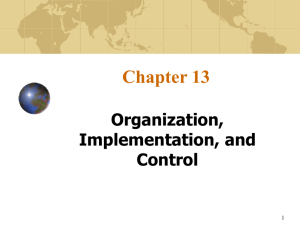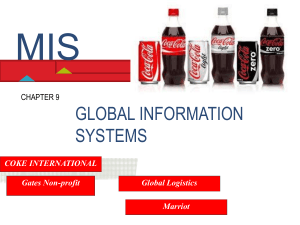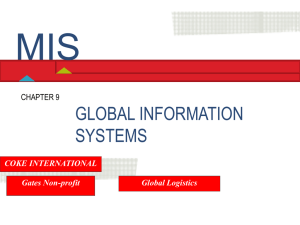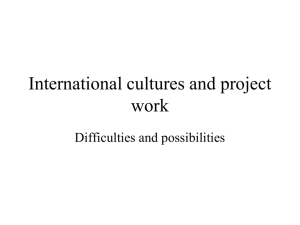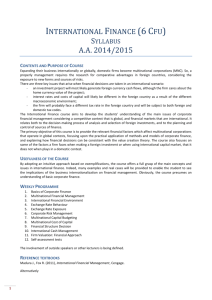Advance Journal of Food Science and Technology 5(12): 1632-1636 2013
advertisement
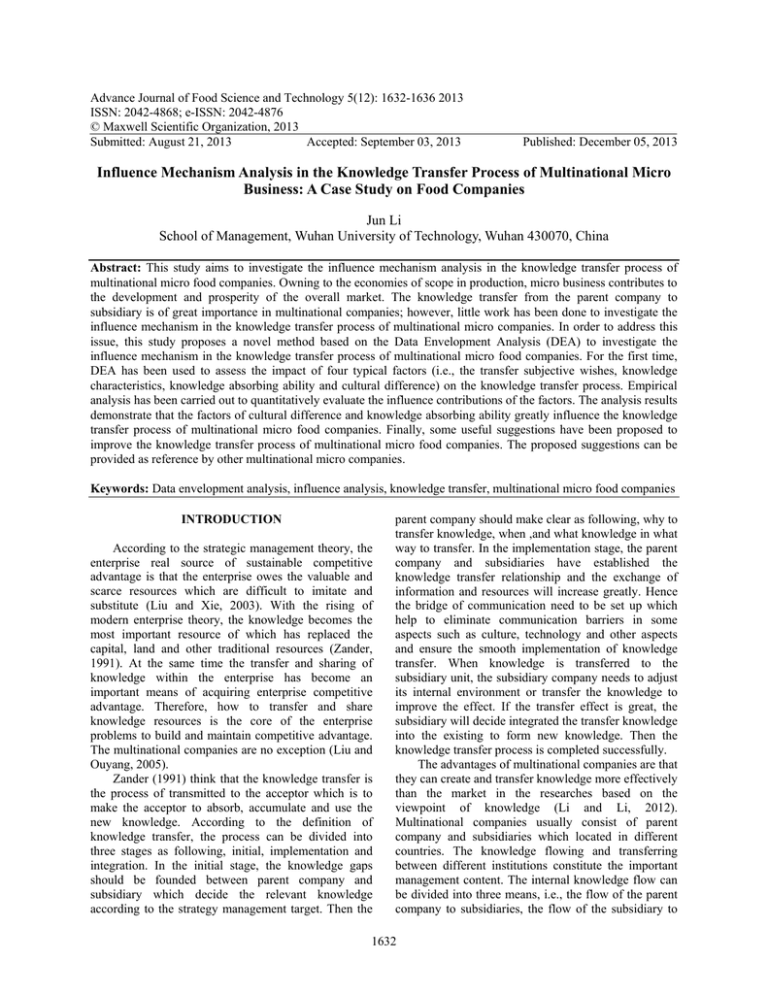
Advance Journal of Food Science and Technology 5(12): 1632-1636 2013 ISSN: 2042-4868; e-ISSN: 2042-4876 © Maxwell Scientific Organization, 2013 Submitted: August 21, 2013 Accepted: September 03, 2013 Published: December 05, 2013 Influence Mechanism Analysis in the Knowledge Transfer Process of Multinational Micro Business: A Case Study on Food Companies Jun Li School of Management, Wuhan University of Technology, Wuhan 430070, China Abstract: This study aims to investigate the influence mechanism analysis in the knowledge transfer process of multinational micro food companies. Owning to the economies of scope in production, micro business contributes to the development and prosperity of the overall market. The knowledge transfer from the parent company to subsidiary is of great importance in multinational companies; however, little work has been done to investigate the influence mechanism in the knowledge transfer process of multinational micro companies. In order to address this issue, this study proposes a novel method based on the Data Envelopment Analysis (DEA) to investigate the influence mechanism in the knowledge transfer process of multinational micro food companies. For the first time, DEA has been used to assess the impact of four typical factors (i.e., the transfer subjective wishes, knowledge characteristics, knowledge absorbing ability and cultural difference) on the knowledge transfer process. Empirical analysis has been carried out to quantitatively evaluate the influence contributions of the factors. The analysis results demonstrate that the factors of cultural difference and knowledge absorbing ability greatly influence the knowledge transfer process of multinational micro food companies. Finally, some useful suggestions have been proposed to improve the knowledge transfer process of multinational micro food companies. The proposed suggestions can be provided as reference by other multinational micro companies. Keywords: Data envelopment analysis, influence analysis, knowledge transfer, multinational micro food companies INTRODUCTION According to the strategic management theory, the enterprise real source of sustainable competitive advantage is that the enterprise owes the valuable and scarce resources which are difficult to imitate and substitute (Liu and Xie, 2003). With the rising of modern enterprise theory, the knowledge becomes the most important resource of which has replaced the capital, land and other traditional resources (Zander, 1991). At the same time the transfer and sharing of knowledge within the enterprise has become an important means of acquiring enterprise competitive advantage. Therefore, how to transfer and share knowledge resources is the core of the enterprise problems to build and maintain competitive advantage. The multinational companies are no exception (Liu and Ouyang, 2005). Zander (1991) think that the knowledge transfer is the process of transmitted to the acceptor which is to make the acceptor to absorb, accumulate and use the new knowledge. According to the definition of knowledge transfer, the process can be divided into three stages as following, initial, implementation and integration. In the initial stage, the knowledge gaps should be founded between parent company and subsidiary which decide the relevant knowledge according to the strategy management target. Then the parent company should make clear as following, why to transfer knowledge, when ,and what knowledge in what way to transfer. In the implementation stage, the parent company and subsidiaries have established the knowledge transfer relationship and the exchange of information and resources will increase greatly. Hence the bridge of communication need to be set up which help to eliminate communication barriers in some aspects such as culture, technology and other aspects and ensure the smooth implementation of knowledge transfer. When knowledge is transferred to the subsidiary unit, the subsidiary company needs to adjust its internal environment or transfer the knowledge to improve the effect. If the transfer effect is great, the subsidiary will decide integrated the transfer knowledge into the existing to form new knowledge. Then the knowledge transfer process is completed successfully. The advantages of multinational companies are that they can create and transfer knowledge more effectively than the market in the researches based on the viewpoint of knowledge (Li and Li, 2012). Multinational companies usually consist of parent company and subsidiaries which located in different countries. The knowledge flowing and transferring between different institutions constitute the important management content. The internal knowledge flow can be divided into three means, i.e., the flow of the parent company to subsidiaries, the flow of the subsidiary to 1632 Adv. J. Food Sci. Technol., 5(12): 1632-1636, 2013 the parent company and the flow between the subsidiaries (Li and Chen, 2009). So the multinational company's internal knowledge transfer can be summarized as three types, i.e., the transfer of company to subsidiary, transfer of subsidiary to the parent company and transfer between the subsidiaries according to the above division (Li and Chen, 2009). In the early period of subsidiaries, the main form of knowledge transfer is from parent company to subsidiaries. By this way the subsidiaries can improve the subsidiary weak knowledge base and the competitiveness of the subsidiary which can make up for disadvantages in strange environment. Therefore, the transfer of parent company to subsidiary has received considerable attentions; among the influencing factors of the knowledge transfer process from parent company to subsidiaries are of great importance to establish countermeasures to the knowledge transfer. However, little work has been done to investigate the influence mechanism in the knowledge transfer process of multinational micro food companies from parent company to subsidiaries (Zhu and Li, 2011). In order to investigate the influence mechanism in the knowledge transfer process of multinational micro food companies from parent company to subsidiaries, this study presents a novel method based on the Data Envelopment Analysis (DEA) to address this issue. Empirical analysis has been carried out to quantitatively evaluate the influence effect of four typical factors on the knowledge transfer process. These factors include the transfer subjective wishes, knowledge characteristics, knowledge absorbing ability and cultural difference. For the first time, useful suggestions have been provided as references for multinational micro food companies to make effective decisions in the knowledge transfer process from parent company to subsidiaries. THE DATA ENVELOPMENT' ANALYSIS (DEA) T θ= • • The Decision Making Unit (DMU) in DEA can process multiple inputs and outputs No prior information is requested in DEA performance evaluation; and The subjective factors could be avoided T (1) a I where, θ is the efficiency of a DMU to other DMUs; a and b are the weights of inputs and outputs, respectively. To obtain maximized θ, (1) need subject to: T b Y = max( ) θ T a I T b Yc ≤ 1, ( c= 1, 2, ..., m ) s.t T a Ic a ≥ 0, b ≥ 0 (2) Inputs and output of the DEA model: As mentioned above, little work has been done to investigate the influence mechanism in the knowledge transfer process of multinational micro food companies from parent company to subsidiaries and hence it is very necessary to address this issue (Zeng, 2012). The factors of the transfer subjective wishes, knowledge characteristics, knowledge absorbing ability and cultural difference should be included in the investigation (Wang, 2012). Hence, in this study these four factors have been selected as the inputs of the DEA model. The outputs are the efficiency of the knowledge transfer. • • Theory of DEA: The Data Envelopment Analysis (DEA) (Banker et al., 1984) is very effective to analyze input-output data with respect to their efficacies. The advantages of DEA can be expressed as follows Jahanshahloo et al. (2011): • b Y • Let the inputs are I = [i 1 , i 2 , … i m ] and the outputs are Y = [y 1 , y 2 , … y n ], then the efficiency of a DMU is • Banker et al. (1984): 1633 The transfer subjective wishes: It seems that the parent company is willing to transfer knowledge depending on the strategic status of subsidiaries. The parent company tends to transfer the core knowledge to a subsidiary in the higher status. In the initial stages of knowledge transfer, the parent company will choose target subsidiaries according to their strategy status. Then the content of the knowledge will be decided to make it possible to the knowledge transfer. The knowledge characteristics: Knowledge can be divided into explicit knowledge and tacit knowledge according to its characteristics. Explicit knowledge can be illustrated by words or diagrams, which is easy to communicate and transfer. Tacit knowledge is highly personalized and cannot be explained in words or diagrams; hence it is difficult to communicate and transfer. The knowledge characteristics determine the degree of difficulty and effects in the knowledge transfer process. The knowledge absorbing ability: This factor refers to the identification of absorptive capacity of a subsidiary in the knowledge transfer process. The digestion and application ability of the subsidiary on valuable new information will affect the effect of knowledge transfer. The cultural difference: This factor refers to relationship or distance between the mother and Adv. J. Food Sci. Technol., 5(12): 1632-1636, 2013 child companies. Any knowledge transfer activities has a specific cultural background; the cultural differences between mother and child companies will often conflict each other, leading to negative impact on knowledge transfer, even decline of knowledge transfer. The greater the cultural differences between mother and child companies, the greater the difficulty of knowledge transfer. multinational micro food companies from parent company to subsidiaries. One can also note that the efficiency of the knowledge absorbing ability is the second large value. This means the knowledge absorbing ability significantly enhances the efficacy of the knowledge transfer process. The contributions of the transfer subjective wishes and the knowledge characteristics are small and they do not play leading roles in the knowledge transfer process of multinational micro food companies from parent company to subsidiaries. In output analysis in Fig. 3, the largest value of efficiency is the factor of transfer subjective wishes. This is means the factor of transfer subjective wishes is less sensitive than the other three factors in the knowledge transfer process of multinational micro food companies from parent company to subsidiaries. In contrast, the factor of the cultural difference presents the smallest efficiency, which indicates that this factor is very important in the knowledge transfer process. The analysis result in Fig. 3 is agrees well with the empirical results in Fig. 2. The factors of the cultural difference and the knowledge absorbing ability significantly influence the knowledge transfer process of multinational micro food companies from parent company to subsidiaries. The research flowchart of the proposed DEA model in knowledge transfer is shown in Fig. 1. EMPIRICAL ANALYSIS DEA results: In order to investigate the influence mechanism in the knowledge transfer process of multinational micro food companies from parent company to subsidiaries, the statistical data of 10 multinational micro food companies in China during 2004 to 2010 has been used to conduct the DEA empirical analysis. Figure 2 and 3 show the influence analysis results of the DEA empirical analysis. In input analysis in Fig. 2 it can be seen that the efficiency of the cultural difference is the largest one. This means the factor of cultural difference is the leading one in the knowledge transfer process of Input variables: · transfer subjective wishes · knowledge characteristics · knowledge absorbing ability · cultural difference DEA model Knowledge transfer performance Influence mechanism Fig. 1: Research flowchart of the proposed DEA model in knowledge transfer 1 0.9 Knowledge characteristics Efficiency 0.8 0.7 Transfer subjective wishes Cultural difference 0.6 0.5 Knowledge absorbing ability 0.4 0.3 0.2 1 3 2 Factors Fig. 2: Efficiency of the influence factors in input analysis 1634 4 Adv. J. Food Sci. Technol., 5(12): 1632-1636, 2013 1.8 1.6 Knowledge absorbing ability Efficiency 1.4 1.2 1 Cultural difference 0.8 Knowledge characteristics Transfer subjective wishes 0.6 0.4 0.2 1 2 3 4 Factors Fig. 3: Efficiency of the influence factors in output analysis Suggestions: In order to improve the knowledge transfer process of multinational micro food companies from parent company to subsidiaries, the following countermeasures can be adopted to improve the effect. • • Promote the cultural fusion between parentsubsidiary corporations: In order to avoid the barriers caused by cultural differences, the mutual communication and coordination should be promoted between the parent company to subsidiary and realize the parent-subsidiary fusion. In the effort to promote the cultural fusion, the parent company should take advanced native country culture and infiltrate to the subsidiaries; in addition the parent company should respect its subsidiaries native culture fully and absorb the reasonable content. In the process of parentsubsidiary cultural integration, the parent company should give full consideration to its expatriates in the communication and coordination of parentsubsidiary culture and subsidiaries should have an open attitude towards the culture of the parent company and integrate it into existing culture. Improve the knowledge absorbing ability of subsidiaries: If the knowledge absorbing ability of the subsidiaries is strong and the initiative and enthusiasm in the process of knowledge transfer are high, then the speed is faster and the depth and breadth also have obvious improvement. The following measures are helpful to improve the subsidiary absorbing capacity. First, training and education activities should be carried out inside the unit regularly to improve the technology and knowledge level. Second, the research input should be paid attention. As well known, the research is not only help promoting innovation, but also is beneficial to introduce new knowledge and • improve its absorption ability. Third, the learning strength should be improved and effective learning methods should be developed. The systematic study with targeted goals should be carried on combining the above measures to strengthen the absorptive capacity of subsidiaries. Fourth, good learning mechanisms should be formed, e.g., the learning organization should be set up inside the unit, the culture values should be promoted, communication with each other should be encouraged and tolerant attitude should be adopted for the wrong action of the staff. Improve the knowledge transferring ability of parent company: From the view of the parent company, considerable transfer ability is also needed to realize the established transfer effect in addition to the transferring knowledge to subsidiaries. As a provider of knowledge, the desire of parent company will determine its ability. If the desire is strong, the parent company will take appropriate measures to improve its ability to transfer knowledge. Knowledge transfer is always inseparable from people involvement, the parent company usually transfer knowledge by expatriates, so good expatriates selection mechanism will help to enhance the transfer ability. CONCLUSION The knowledge transfer from the parent company to subsidiary is of great importance in multinational companies; however, little work has been done to investigate the influence mechanism in the knowledge transfer process of multinational micro companies. Hence, for the first time, the Data Envelopment Analysis (DEA) is proposed to investigate the influence 1635 Adv. J. Food Sci. Technol., 5(12): 1632-1636, 2013 mechanism in the knowledge transfer process of multinational micro food companies in this study. Empirical analysis has been carried out to quantitatively evaluate the influence contributions of four factors (i.e., the transfer subjective wishes, knowledge characteristics, knowledge absorbing ability and cultural difference) on the knowledge transfer process of multinational micro food companies from parent company to subsidiaries. The analysis results show that the factors of the cultural difference and the knowledge absorbing ability significantly influence the knowledge transfer process of multinational micro food companies from parent company to subsidiaries. Hence, to improve the performance of knowledge transfer the multinational micro food companies should perfectly manage the cultural differences between parent company and subsidiaries; they also need improve the knowledge absorbing ability of subsidiaries. These suggestions can be provided as reference by other multinational micro companies. REFERENCES Banker, R., A. Charnes and W. Cooper, 1984. Some methods for estimating technical and scale inefficiencies in data envelopment analysis. Manage. Sci., 30(9): 1078-1092. Jahanshahloo, G., F. Lotfi, Y. Jafari and R. Maddahi, 2011. Selecting symmetric weights as a secondary goal in DEA cross-efficiency evaluation. Appl. Math. Modell., 35(1): 544-549. Li, C. and L. Li, 2012. Knowledge transfer model within multinational corporations. J. Wuhan Univ., Technol. Inform. Manage. Eng., 34(5): 658-662. Li, C. and X. Chen, 2009. Study on the model of enterprises coordinative knowledge innovation. J. Wuhan Univ., Technol. Inform. Manage. Eng., 31(1): 109-112. Liu, C. and H. Xie, 2003. On the main factors of knowledge absorptive capacity of enterprise. Stud. Sci. Sci., 21(3): 307-310. Liu, F. and L. Ouyang, 2005. Study on knowledge transfer process, influencing factors and countermeasures within MNCs. Sci. Sci. Manage. S. T., 26(10): 40-43. Wang, J., 2012. Research on operation strategy of multinational small and medium-sized enterprises. China Bus. Trade, 30: 15-19. Zander, U., 1991. Exploiting a technological edge: Voluntary and involuntary dissemination of technology. Ph.D. Thesis, Institute of International Business, Stockholm School of Economics, Stockholm, pp: 8-13. Zeng, H., 2012. Research on business competition strategy of multinational small and medium-sized enterprises. Soc. Sci., 1: 65-68. Zhu, Y. and C. Li, 2011. Research on the relationships between knowledge innovation and the development of enterprise innovation system. Sci. Technol. Prog. Policy, 28(1): 68-72. 1636
